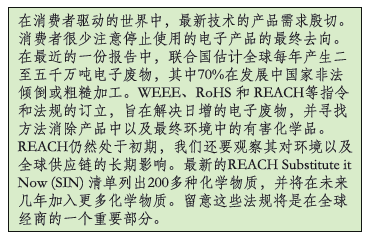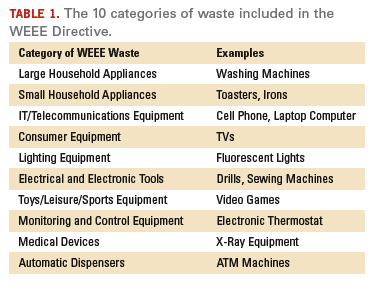
The roles WEEE, RoHS and REACH play in the environment.
Let’s face it; we live in a world that craves the newest, fastest technologies. Our insatiable appetite for the hottest trends can be compared to the coal that fueled the factories of the Industrial Revolution, and the multitude of electronic and electrical products that we purchase (cell phones, personal computers, flat screen televisions) are the pollution that resulted. In a recent report, the United Nations estimated the total amount of electronic waste, or e-waste, generated globally ranges between 20 million and 50 million tons per year, with 70% of that waste either illegally dumped or crudely processed in developing nations. E-waste contains more than 1,000 different substances, including lead, mercury and cadmium, and some environmental groups estimate that the United Nations’ figures could triple by 2010. That is a substantial amount of toxins with the possibility of entering landfills, water sources and our bodies. But there are directives and regulations in force to address, to audit and to control the swelling stream of e-waste entering the environment. WEEE, RoHS and REACH are the three big names behind the movement, but what do these acronyms represent?
WEEE
The Waste Electrical and Electronic Equipment (WEEE) Directive went into force in the European Union (EU) in 2003. Focusing on the end-of-life management of products, the purpose of the directive is to reduce the amount of e-waste in landfills by increasing the recycling and the reuse of electronic and electrical goods–thus reducing the impact on the environment.
There are 10 categories the waste products fall under. These can be seen with examples of each in Table 1.

WEEE places the financial burden of collection, treatment and recovery of the waste on the manufacturers; distributors must provide a means for the consumer to return their e-waste free of charge. Each EU member state has control over its own WEEE policy process and regulations. WEEE also requires EU members to establish systems to prevent the exportation of untreated e-waste. Exported products for reuse, for instance computers earmarked for schools in developing countries, are permitted. Non-EU manufacturers who wish to export products to be used within the European Union must meet the WEEE Directive.
Other countries have begun to show interest in adopting the WEEE Directive, such as Japan and China. Japan is showing signs of implementing design changes, such as eco-design and automated disassembly using smart materials (ADSM). China has increased the number of recycling plants and has plans to introduce recycling treatment facilities.
But there are severe cracks in the system. Although each country is allowed to regulate WEEE, some countries do not keep records of the amount of e-waste dumped in landfills each year. In a recent article in Ghana News Today, it was reported that as much as 75% of e-waste generated in the EU is unaccounted for. Where does the waste end up? One answer is in the landfills and the dumps of developing countries.
A report in The Swazi Observer discussed a loophole in the system. It has been alleged that facilities in the United Kingdom have shipped computers that are inoperable to developing countries, such as Ghana, Nigeria, and China– but marked them for reuse. When the useless computers arrive, they end up in dumps and landfills where often the impoverished local people burn the e-waste to remove the precious metals. Not only are the deadly fumes released into the atmosphere, but also are inhaled by the workers, many of them children. Toxic waste products also enter the soil and ground water, continuing the contamination process. The United Kingdom’s Environment Agency’s National Investigations Crime Team has begun an investigation into the allegations.
RoHS
The Restriction of Hazardous Substances Directive (RoHS) complements WEEE. The directive came into force in the European Union in 2006 and restricts the permitted concentration of six hazardous materials found in electrical and electronic products by assigning a maximum concentration value for each material. The materials are: lead, cadmium, mercury, hexavalent chromium, and two flame retardants, polybrominated biphenyl and polybrominated diphenyl ether. The maximum permitted concentration for each is 0.1% or 1000 ppm– with the exception of cadmium which is allowed 0.01% or 100 ppm.
While WEEE’s objective is to keep recycling and recovery in mind during the design process, RoHS seeks to reduce the amount of hazardous chemicals entering the landfills. Each EU member state has control over the enforcement and implementation policies, similar to WEEE. Also, non-EU members wanting to export within the European Union must meet the RoHs Directive.
But times do change, and the original RoHS Directive might be changing as well. According to Michael Kirschner, president of Design Chain Associates LLC, information has been leaked that five additional substances may be added to the list. Medical devices and monitoring/control instruments (categories 8 and 9 of the WEEE Directive) could be brought into the scope as well.
REACH
The Registration, Evaluation, Authorization and Restriction of Chemical Substances (REACH) is the latest regulation in the European Union. It entered into force in 2007. The goals of the regulation are to better protect the public’s health and the environment by either banning hazardous substances or by reducing their use when able. Also, REACH wants to influence the chemical industry to design and to produce more eco-friendly products. Over the next decade, REACH hopes to register thousands of chemicals manufactured in the EU, as well as chemicals imported into the EU, into a central database. The European Chemicals Agency (ECHA) located in Helsinki, Finland manages this database.
In September of this year, a preliminary list of hazardous chemical substances was published. The Substitute it Now (SIN) List contains over 200 chemical substances that need to be phased out as soon as possible. Included on the list are substances such as dichlorobenzene, used in pesticides, and naphthalene, the primary ingredient in mothballs. In 2009, the ECHA will draft the first list of priority substances that will require authorization to continue to be used in the European Union. According to Michael Kirschner, over 35,000 chemicals have already been pre-registered for that list, and around 40,000 substances will eventually fall within the scope.
REACH places a greater onus on manufacturers, who are required to provide consumer safety information regarding the chemicals present in the products they produce. Manufacturers will also be required to register their substances at a cost of up to 30,000 euros (roughly US$37,600) per substance. The steep price might force some companies to pull their products from the market, but only time will tell.
Although in force for a short period of time, REACH has already had results–both good and bad. “Many substances are no longer being produced or imported into the EU. This is causing some manufacturing to cease or move out of the European Union,” explains Michael Kirschner. “REACH also wants the chemical industry to design and to manufacture more environmentally sound products. If unable to do that, at least make sure users understand the hazards and the risks of the chemicals. Hopefully it will do both.” PCD&F
Margo Lakin is the associate editor for Printed Circuit Design & Fab and can be reached at This email address is being protected from spambots. You need JavaScript enabled to view it..















